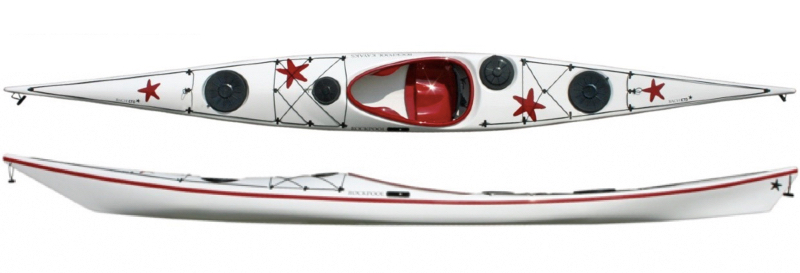Key Specifications:
Length: 515cm (16’11”), Width: 54cm (21.4”), Paddler ≈ 180cm (5’10”) 81kg (180lb)

The Bach Eto is a complete reworking of the Alaw Bach, from the hull up. To understand the changes we first need to understand the Alaw Bach and its history. If you bear with me for a moment we need to take a journey back to 2005 and the birth of a new sea kayak company, Rockpool.
The first sea kayak to emerge from the Rockpool factory was the Alaw, named after a lake on Anglesey. Designed as a fast performance sea kayak for the large paddler. It introduced the concept of a cockpit with a raised knee position to the world of sea kayaking. Similar to that seen in the designs of racing kayaks this gives a more ergonomically efficient sitting position for forwards paddling.
Very soon after it came the smaller Alaw Bach, bach being welsh for small. As was the habit of sea kayak design back then, this boat had the same hull as the Alaw but a lower deck to fit medium sized paddlers. This also gave a lower, more conventional, leg position.
As we now know this isn’t the ideal way to design boats as a smaller paddler also needs a redesigned hull to fit their ergonomics. That, along with a few other design tweaks is what the Bach Eto set out to address. Eto being welsh for 'again'.
Now lets get back to today and the Bach Eto. Since those original boats Rockpool has designed a great boat for small paddlers, the Isel, and the hull from the Eto builds on that. Being for a medium to large sized paddler it is a little longer and wider than the Isel but significantly shorter than the original Alaw Bach.
Also compared to the Alaw Bach, the Eto has had more volume added to the bow and more rocker. These features help lift the bow over waves and give it a drier ride. Increasing the rocker also increases the manoverability but does inevitable reduce the speed, not that it is particularly noticable. This is because the increased stability and better handling that come from the wider and more rockered hull make it easier to keep the paddling cadance up, particularly in rougher water.
What is also noticeable is the increased manuverability, particularly with the boat on edge. Leaning forwards as you edge puts your weight over the new higher volume and wider bow. The increased stability this provides allows you to edge further, confidently which in turn lifts the bow and particularly the stern keels higher in the water. This reduces the turning resistance and enables the boat to turn sharply.
Up on the deck, there is a new addition of a 6 inch hatch in front of the cockpit. Whilst very handy these do inevitably make getting big feet into the cockpit a bit harder, but the new wider cockpit helps to accommodate this.
The deck fittings are Rockpool’s excellently innovative recessed and externally fitted fittings. As well as reducing weight these reduce the potential for leaks. The deck line configuration has also been altered to make the front deck more usable whilst navigating, while also providing storage for those who carry split paddles on the front deck.
As just mentioned the cockpit is now wider, which helps to accommodate medium to large sized paddlers more comfortably, with a wider leg position and more foot room. Also the cockpit rim is wider, in particular there is less gap behind the back rest to the bulkhead. This helps empty more water when the boat is being rescued.
Another stand out feature of the Rockpool range is the seat and footrest setup. These are fitted without any holes drilled in the boat, which eliminates the possibility of leaks. The footrest is an angled full plate footrest which gives puts your feet in a very comfortable and efficient position. Most importantly of all though is the adjustability of the seat and footrest. These both have a wide range of movement forwards and backwards and can be moved independently or together to either adjust the fit or the wind trim.
That being said the wind trim of this boat is excellent. With the seat in a ‘standard' position the boat feels wind neutral with just a hint of weather cocking. That is the compromise that makes the boat manageable to turn into the wind when static. When combined with leaning forward and a bit of edge you couldn’t ask for much more. For help understanding the importance of the seat position with regards to how the boat handles in the wind see Sea Kayaking in the Wind - Understanding the Physics.
With regards to weather cocking, Rockpool also have a unique approach to the skeg in that they make their own skeg blade. This is to control the tolerances of the fit of the blade into the hull and they do a good job with this. There is very little gap where the skeg enters the hull, which doesn’t prevent the skeg from jamming, but it does take smaller pebbles to do it which helps. Also the skeg box doesn’t have the same amount of flare that other boats have which helps reduce the range of particle sizes that can jam in it, reducing the chances of it happening.
Both the skeg and the skeg box are smaller than standard, which gives more storage room in the rear hatch. However the smaller skeg is a compromise. There is enough skeg there to accommodate a boat that has been loaded correctly but if you seriously overload the front you won’t have enough skeg to compensate.
The build quality of the Eto we used was excellent. The build quality of Rockpool boats generally is very high. This means they can make light boats, and they do. Their standard hand layup polyester boats are some of the lightest in the industry and personally we would recommend this layup over any of their fancier, lighter layups. That’s not because there is anything wrong with them. It’s that however well you make a light boat it will be more fragile and less durable. And we do like to not having to treat our boats too gently. That being said their Premier, vaccum bag construction, Epoxy and Carbon Kevlar layups are amazing.
Overall this boat is a marked improvement on the original Alaw Bach. It brings it in line with modern design improvements towards shorter, wider and more rocked boats that are easier to handle in rougher water. However it still easily holds its speed enough to keep up with group paddles.
Finally, one of the most exciting things about this boat is the name Eto as this is suggesting it is a second generation of Rockpool boat. Does that mean there could be more models that are going to be redesigned? If so what next? Could there be an G.T. Eto in the pipeline? Watch this space.

By Philip Clegg
With two decades of working in the sea kayaking industry, Phil can be found on a daily basis coaching and paddling on the coastline of Anglesey. That’s when he’s not travelling the world expeditioning, coaching and testing kit.


